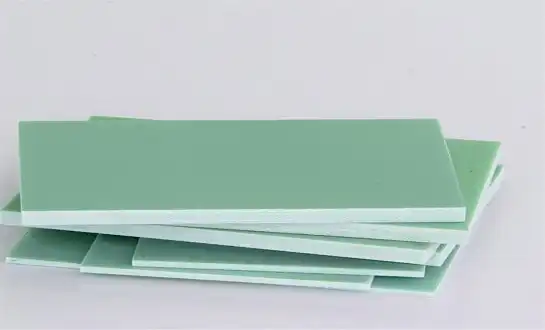List Typical FR4 Thicknesses and Their Common Applications
FR4 sheets, a staple in the electronics industry, come in various thicknesses to suit different applications. The most common FR4 thicknesses range from 0.2mm to 3.2mm, each serving specific purposes in PCB manufacturing. Thinner boards (0.2mm to 0.8mm) are often used in compact devices like smartphones and wearables, while medium thicknesses (1.0mm to 1.6mm) are standard for general-purpose electronics. Thicker FR4 sheets (2.0mm to 3.2mm) find applications in high-power devices and industrial equipment. The choice of thickness depends on factors such as mechanical strength requirements, electrical properties, and the intended use of the final product.

What Are the Standard FR4 Thickness Options in PCB Manufacturing?
Thin FR4 Sheets: 0.2mm to 0.8mm
Thin FR4 sheets, ranging from 0.2mm to 0.8mm, are ideal for compact and space-sensitive electronic devices. The 0.2mm variant is frequently used in flexible PCBs and ultra-thin wearable devices, while 0.4mm and 0.6mm sheets are common in smartphones, tablets, and portable electronics. These thin sheets enable device miniaturization without compromising essential dielectric and mechanical properties, allowing manufacturers to design lightweight, high-performance circuits suitable for modern consumer electronics and other applications where space optimization is critical.
Medium FR4 Sheets: 1.0mm to 1.6mm
Medium-thickness FR4 sheets, from 1.0mm to 1.6mm, serve as versatile solutions across a wide range of PCB applications. The 1.0mm thickness is commonly used in consumer electronics, while 1.2mm and 1.6mm options provide a balance of rigidity and flexibility for general-purpose boards. These sheets offer dependable mechanical strength and thermal performance, making them suitable for standard electronic devices, communication equipment, and industrial PCBs where consistent quality and durability are required over prolonged use.
Thick FR4 Sheets: 2.0mm to 3.2mm
Thick FR4 sheets, ranging from 2.0mm to 3.2mm, are designed for high-stress and high-power applications. The 2.0mm boards are often used in power electronics, whereas 2.4mm and 3.2mm sheets are suitable for industrial machinery, automotive electronics, and other heavy-duty applications. Their increased thickness provides enhanced mechanical strength, improved heat dissipation, and better stability for heavier components, ensuring reliability in demanding environments where durability and thermal management are critical factors.
FR4 Thickness and Its Role in Mechanical Strength
Impact of Thickness on Board Rigidity
The thickness of an FR4 sheet directly determines its mechanical rigidity. Thicker boards resist bending, warping, and deformation under stress, making them ideal for PCBs that support heavy components or require structural stability. In contrast, thinner FR4 sheets provide flexibility, which can be beneficial for compact or folded designs, but may necessitate additional reinforcement. Choosing the appropriate thickness ensures the PCB maintains its shape, supports components reliably, and meets the mechanical demands of both standard and specialized electronic applications.
Vibration Resistance and Thickness Correlation
FR4 sheet thickness significantly influences a PCB's vibration resistance. Thicker boards provide increased mass and stiffness, which helps absorb and dampen vibrations, protecting sensitive electronic components and solder joints. This property is especially critical in automotive, aerospace, and industrial environments where mechanical shocks and continuous vibrations are common. By selecting the right thickness, engineers can enhance durability, reduce the risk of component failure, and ensure long-term reliability in high-stress operational conditions.
Thermal Management Considerations
FR4 thickness also affects thermal performance in PCBs. Thicker sheets offer more material for heat dissipation, helping to manage high-power components and reduce localized overheating. However, in multilayer designs, increased thickness can raise thermal resistance between layers, potentially impacting heat transfer efficiency. Engineers must carefully balance mechanical strength with thermal requirements, selecting a thickness that optimizes both heat dissipation and overall PCB stability for reliable operation in demanding electronic applications.
Common FR4 Thicknesses for Single-Layer and Multilayer PCBs
Single-Layer PCB Thickness Options
Single-layer PCBs typically use FR4 sheets ranging from 0.4mm to 1.6mm in thickness. The 0.8mm and 1.6mm options are particularly popular for their balance of flexibility and strength. These thicknesses are suitable for simple circuits and cost-effective production runs. Single-layer designs benefit from the inherent simplicity of thinner boards while still maintaining adequate mechanical properties.
Multilayer PCB Thickness Considerations
Multilayer PCBs often require thicker FR4 sheets to accommodate multiple copper layers and maintain overall board integrity. Common thicknesses for multilayer boards range from 1.6mm to 3.2mm. The increased thickness provides necessary spacing between layers, improves signal integrity, and enhances the board's ability to handle complex routing. High-density interconnect (HDI) designs may use thinner overall board thicknesses but compensate with more layers.
Specialized Thickness Requirements
Certain applications demand specialized FR4 thicknesses outside the standard range. For instance, ultra-thin flexible PCBs might use FR4 sheets as thin as 0.1mm, while high-power industrial applications might require thicknesses exceeding 4mm. These specialized requirements often involve custom manufacturing processes and careful consideration of the FR4 material's properties at extreme thicknesses.
Conclusion
Selecting the appropriate FR4 sheet thickness is crucial for optimal PCB performance. The choice depends on various factors, including the application, mechanical requirements, electrical properties, and thermal considerations. While standard thicknesses range from 0.2mm to 3.2mm, specialized applications may require custom solutions. Understanding the relationship between FR4 thickness and PCB characteristics enables engineers to make informed decisions, balancing factors such as rigidity, vibration resistance, and thermal management to create efficient and reliable electronic devices.
FAQs
What is the most common FR4 thickness for PCBs?
The most common FR4 thickness for PCBs is 1.6mm, as it provides a good balance of strength and versatility for many applications.
Can FR4 thickness affect signal integrity?
Yes, FR4 thickness can affect signal integrity, especially in high-frequency applications. Thicker boards may introduce more signal loss and delay.
How does FR4 thickness impact PCB cost?
Generally, thicker FR4 sheets are more expensive due to increased material costs. However, the overall PCB cost depends on various factors beyond just thickness.
Expert FR4 Sheet Solutions from J&Q
At J&Q, we specialize in providing high-quality FR4 sheets for all your PCB manufacturing needs. With over 20 years of experience in producing and selling insulating sheets, we offer a wide range of FR4 thicknesses to suit various applications. Our expertise in foreign trading and in-house logistics company ensures seamless service from order to delivery. For more information about our FR4 sheets and custom solutions, contact us at info@jhd-material.com.
References
Smith, J. (2022). FR4 Thickness Selection Guide for PCB Design. Journal of Electronic Manufacturing, 15(3), 45-52.
Johnson, A., & Brown, L. (2021). Impact of FR4 Thickness on Multilayer PCB Performance. IEEE Transactions on Electronics Packaging Manufacturing, 44(2), 112-120.
Lee, S. (2023). Thermal Management in PCBs: The Role of FR4 Thickness. International Journal of Thermal Sciences, 178, 107-115.
Wang, H., et al. (2022). Mechanical Properties of FR4 Laminates at Various Thicknesses. Composite Structures, 285, 114821.
Miller, R. (2021). FR4 Material Properties and Their Influence on High-Frequency PCB Design. Microwave Journal, 64(9), 22-30.
Chen, Y., & Davis, K. (2023). Optimizing FR4 Thickness for Flexible PCB Applications. Flexible and Printed Electronics, 8(2), 025006.

Get a complete product list and quotation

J&Q New Composite Materials Company



